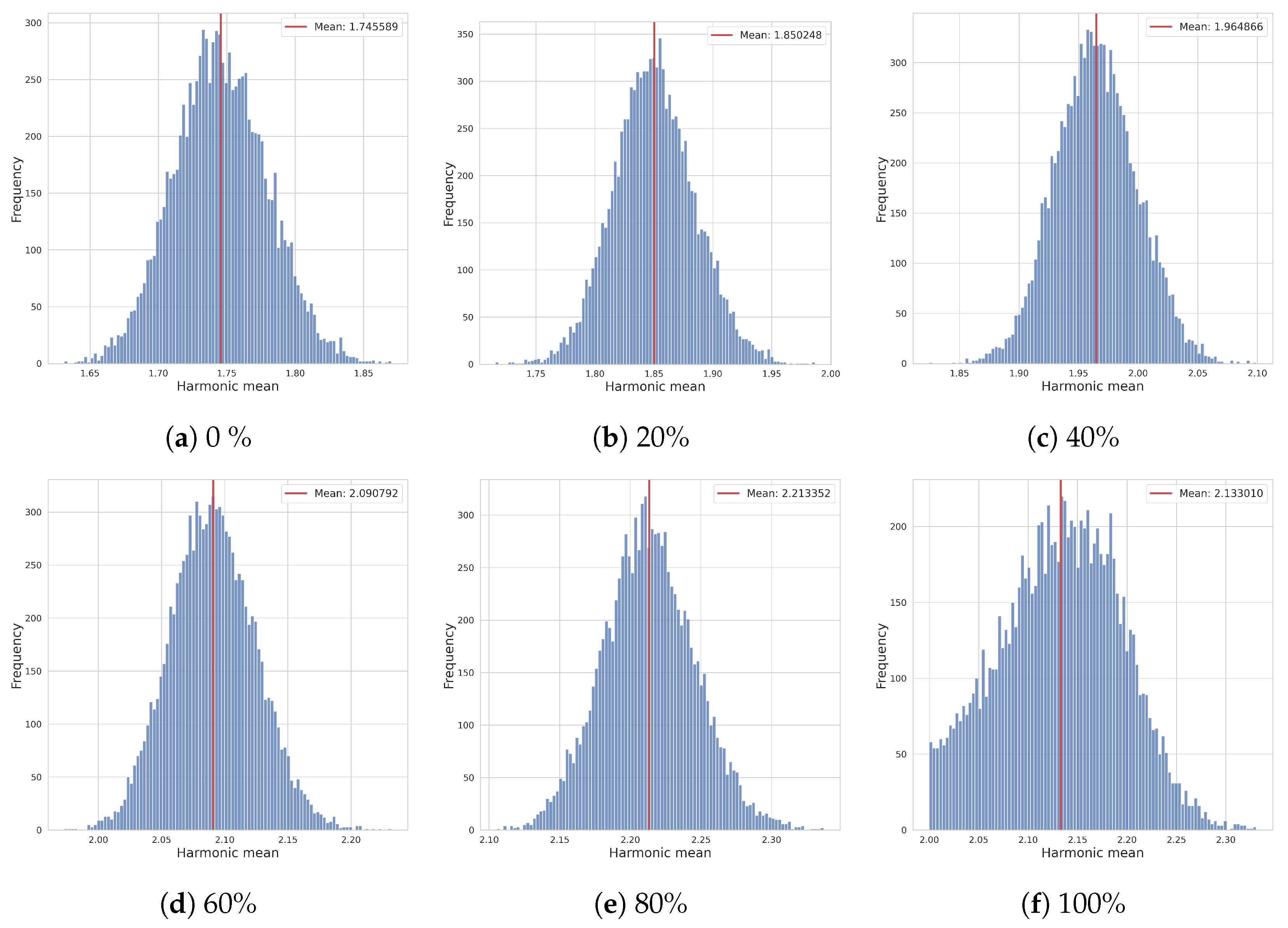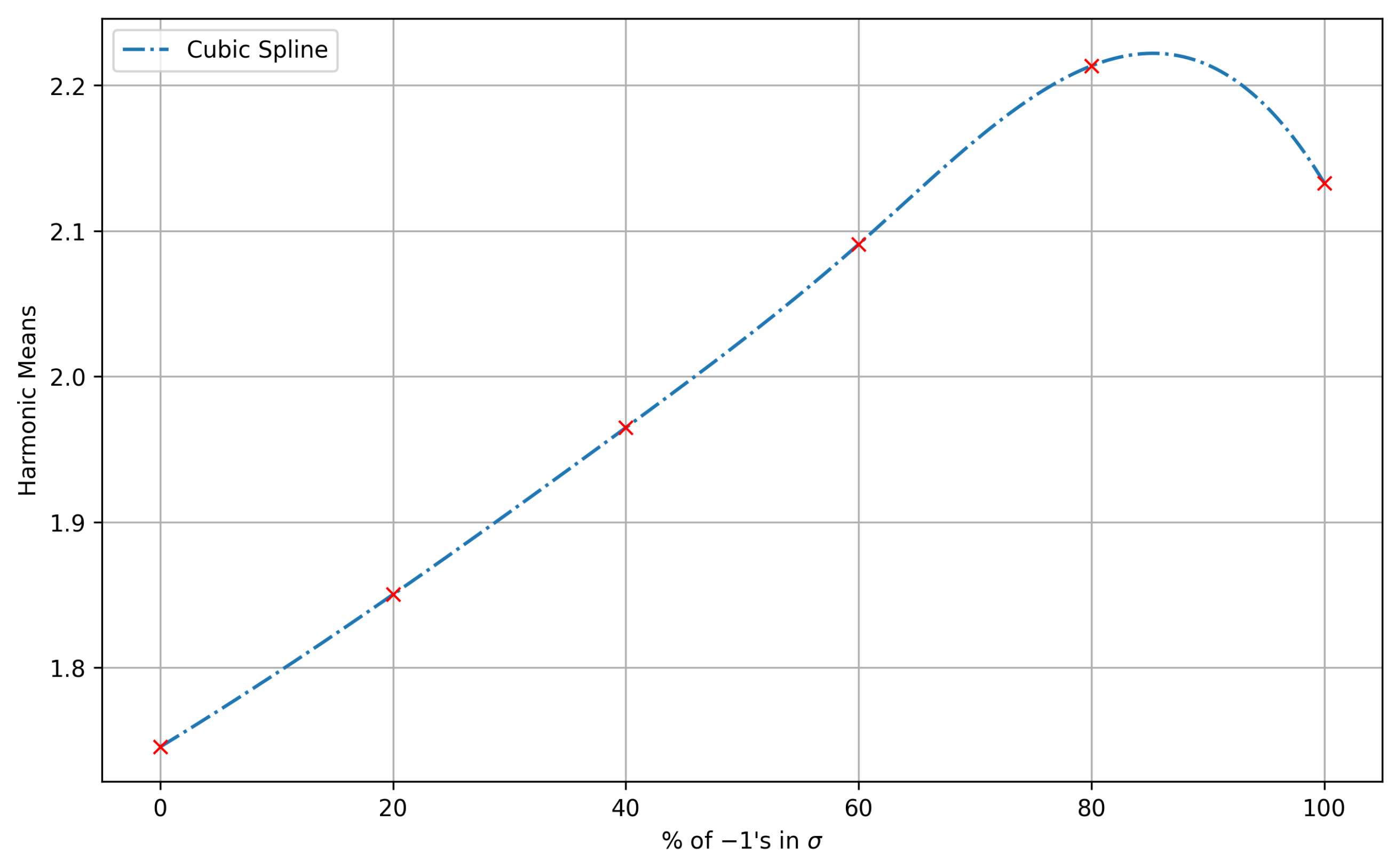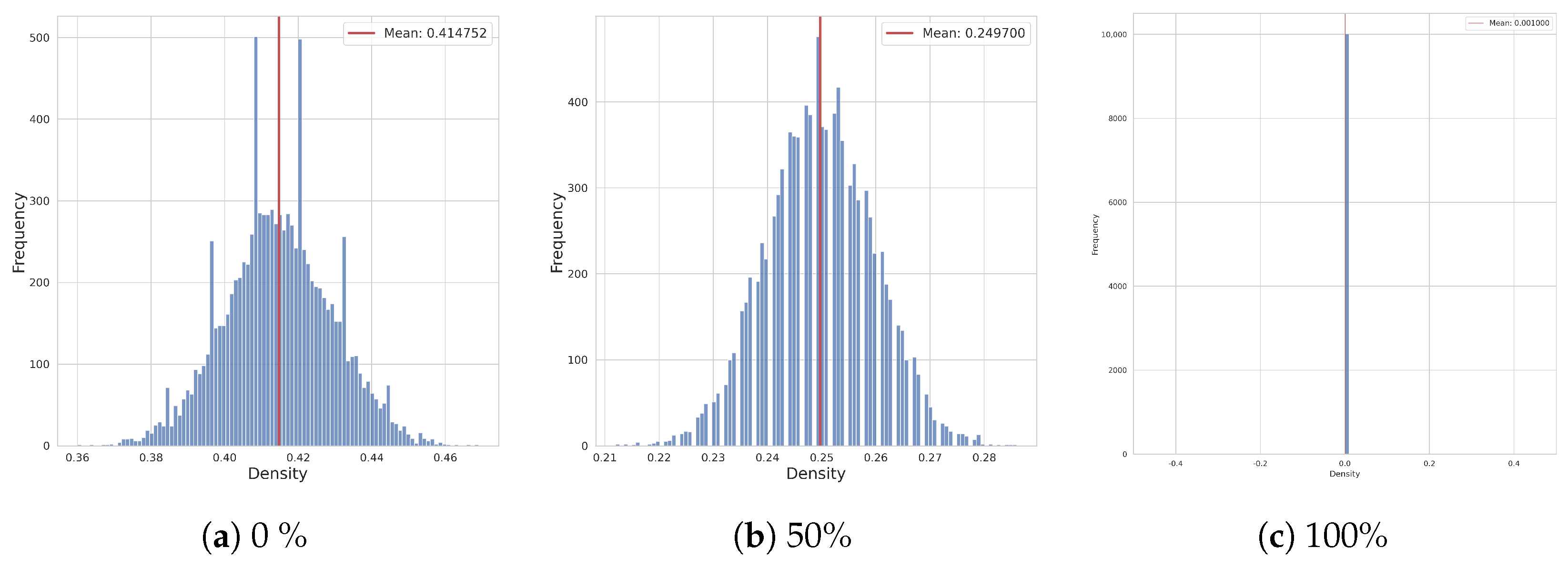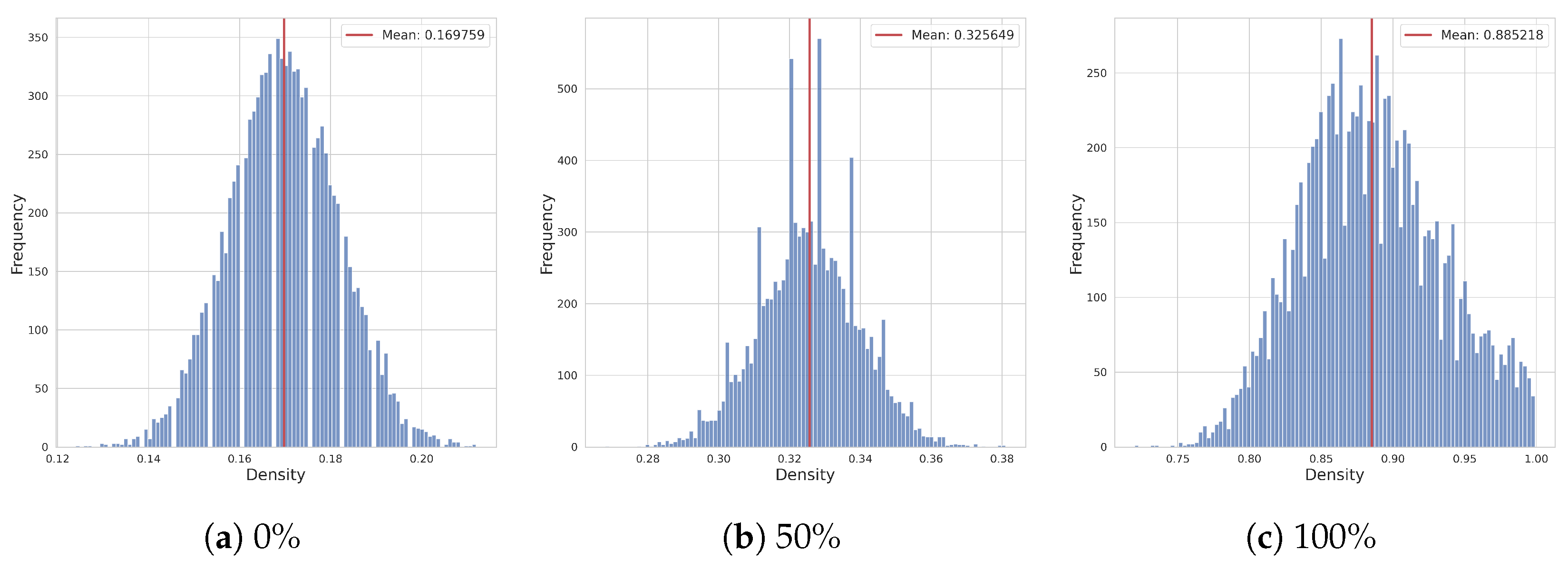Semi-Regular Continued Fractions with Fast-Growing Partial Quotients
Abstract
:1. Introduction
2. Background and Auxiliary Results
- , , , and ,
- ,
- .
3. Lower Bound for Hausdorff Dimension
4. Upper Bound for the Hausdorff Dimension
5. Numerical Analysis
5.1. Harmonic Means of Partial Quotients
5.2. Proportion of the Number 1 and 2 in Partial Quotients
6. Conclusions
Author Contributions
Funding
Data Availability Statement
Conflicts of Interest
References
- Cotan, P.; Teşeleanu, G. Continued fractions applied to a family of RSA-like cryptosystems. In Proceedings of the International Conference on Information Security Practice and Experience, Taipei, Taiwan, 23–25 November 2022; pp. 589–605. [Google Scholar]
- Waldschmidt, M. Continued Fraction Introduction and application. Inst. De Jussieu Univ. Pierre Marie Curie Paris TU Kirtipur Kathmandu Nepal Novemb. 2015, 2, 1. [Google Scholar]
- Einsiedler, M.; Ward, T. Ergodic Theory; Citeseer: Princeton, NJ, USA, 2010. [Google Scholar]
- Colín-Cervantes, J.D.; Sánchez-López, C.; Ochoa-Montiel, R.; Torres-Muñoz, D.; Hernández-Mejía, C.M.; Sánchez-Gaspariano, L.A.; González-Hernández, H.G. Rational approximations of arbitrary order: A survey. Fractal Fract. 2021, 5, 267. [Google Scholar] [CrossRef]
- Jazar, R.N. Functional Continued Fractions. In Approximation Methods in Science and Engineering; Springer: New York, NY, USA, 2020. [Google Scholar]
- Berthé, V.; Dajani, K.; Kalle, C.; Krawczyk, E.; Kuru, H.; Thevis, A. Rational approximations, multidimensional continued fractions and lattice reduction. arXiv 2023, arXiv:2303.07777. [Google Scholar]
- Karpenkov, O.N. Geometry of Continued Fractions; Springer Nature: Berlin/Heidelberg, Germany, 2022; Volume 26. [Google Scholar]
- Ibran, Z.M.; Aljatlawi, E.A.; Awin, A.M. On continued fractions and their applications. J. Appl. Math. Phys. 2022, 10, 142–159. [Google Scholar] [CrossRef]
- Dyussekenov, D.; Kadyrov, S. Weakly divergent partial quotients. Asian-Eur. J. Math. 2020, 13, 2050158. [Google Scholar] [CrossRef]
- Bakhtawar, A.; Bos, P.; Hussain, M. Hausdorff dimension of an exceptional set in the theory of continued fractions. Nonlinearity 2020, 33, 2615. [Google Scholar] [CrossRef]
- Patiño Ortiz, J.; Patiño Ortiz, M.; Martínez-Cruz, M.Á.; Balankin, A.S. A brief survey of paradigmatic fractals from a topological perspective. Fractal Fract. 2023, 7, 597. [Google Scholar] [CrossRef]
- Fernández-Martínez, M. A survey on fractal dimension for fractal structures. Appl. Math. Nonlinear Sci. 2016, 1, 437–472. [Google Scholar] [CrossRef]
- Nakajima, Y.; Takahasi, H. The dimension theory of semi-regular continued fractions. arXiv 2022, arXiv:2209.08318. [Google Scholar]
- Fang, L.; Ma, J.; Song, K. Some exceptional sets of Borel–Bernstein theorem in continued fractions. Ramanujan J. 2021, 56, 891–909. [Google Scholar] [CrossRef]
- Dajani, K.; Kraaikamp, C. The mother of all continued fractions. In Colloquium Mathematicum; Polska Akademia Nauk, Instytut Matematyczny PAN: Warszawa, Poland, 2000; Volume 84, pp. 109–123. [Google Scholar]
- Kraaikamp, C. A new class of continued fraction expansions. Acta Arith. 1991, 57, 1–39. [Google Scholar] [CrossRef]
- Duverney, D.; Shiokawa, I. Irrationality exponents of semi-regular continued fractions. Tokyo J. Math. 2023, 41, 1–21. [Google Scholar] [CrossRef]
- Sarma, R.; Kushwaha, S. On Finite Semi-regular Continued Fractions. Integers 2016, 16, A45. [Google Scholar]
- Kalle, C.; Kempton, T.; Verbitskiy, E. The random continued fraction transformation. Nonlinearity 2017, 30, 1182. [Google Scholar] [CrossRef]
- Falconer, K. Fractal Geometry; Wiley: New York, NY, USA, 1990. [Google Scholar]
- Fan, A.H.; Liao, L.M.; Wang, B.W.; Wu, J. On Khintchine exponents and Lyapunov exponents of continued fractions. Ergod. Theory Dyn. Syst. 2009, 29, 73–109. [Google Scholar] [CrossRef]
- Khintchine, A. Metrische kettenbruchprobleme. Compos. Math. 1935, 1, 361–382. [Google Scholar]
- Iosifescu, M.; Kraaikamp, C. Metrical Theory of Continued Fractions; Springer Science & Business Media: Dordrecht, The Netherlands, 2013; Volume 547. [Google Scholar]
- The On-Line Encyclopedia of Integer Sequences. Available online: https://oeis.org/ (accessed on 8 May 2024).




Disclaimer/Publisher’s Note: The statements, opinions and data contained in all publications are solely those of the individual author(s) and contributor(s) and not of MDPI and/or the editor(s). MDPI and/or the editor(s) disclaim responsibility for any injury to people or property resulting from any ideas, methods, instructions or products referred to in the content. |
© 2024 by the authors. Licensee MDPI, Basel, Switzerland. This article is an open access article distributed under the terms and conditions of the Creative Commons Attribution (CC BY) license (https://creativecommons.org/licenses/by/4.0/).
Share and Cite
Kadyrov, S.; Kazin, A.; Mashurov, F. Semi-Regular Continued Fractions with Fast-Growing Partial Quotients. Fractal Fract. 2024, 8, 436. https://doi.org/10.3390/fractalfract8080436
Kadyrov S, Kazin A, Mashurov F. Semi-Regular Continued Fractions with Fast-Growing Partial Quotients. Fractal and Fractional. 2024; 8(8):436. https://doi.org/10.3390/fractalfract8080436
Chicago/Turabian StyleKadyrov, Shirali, Aiken Kazin, and Farukh Mashurov. 2024. "Semi-Regular Continued Fractions with Fast-Growing Partial Quotients" Fractal and Fractional 8, no. 8: 436. https://doi.org/10.3390/fractalfract8080436
APA StyleKadyrov, S., Kazin, A., & Mashurov, F. (2024). Semi-Regular Continued Fractions with Fast-Growing Partial Quotients. Fractal and Fractional, 8(8), 436. https://doi.org/10.3390/fractalfract8080436





